The Meizu M3 Note vs. Xiaomi Redmi Note 3 Review: Comparing Notes
by Matt Humrick on July 12, 2016 8:00 AM EST- Posted in
- Smartphones
- Mobile
- Xiaomi
- Meizu
- Redmi
GPU Performance
The Meizu M3 note uses an ARM Mali-T860MP2 GPU running at up to 546MHz. This is ARM’s current mid-range offering based on its Midgard architecture. The T860 shares the same feature set as ARM’s premiere T880, but uses only 2 ALUs/core instead of 3 ALUs/core like the T880, reducing overall shader performance by up to 50%. The T860 brings hardware support for OpenGL ES 3.1 + Android Extension Pack (AEP); however, the M3 note seems to be lacking driver support for some features like tessellation.
Xiaomi’s Redmi Note 3 uses an Adreno 510 GPU running at up to 600MHz. Qualcomm does not disclose architectural details about its processors, so all we can really say for sure is that this GPU is a member of the current Adreno series along with the Adreno 530, Qualcomm’s highest-performing GPU. The Adreno 510 also supports OpenGL ES 3.1 + Android Extension Pack (AEP), and the Redmi Note 3 did not experience any compatibility issues running through our benchmark suite.
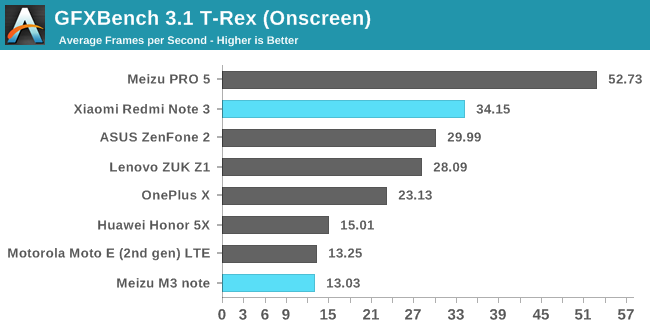
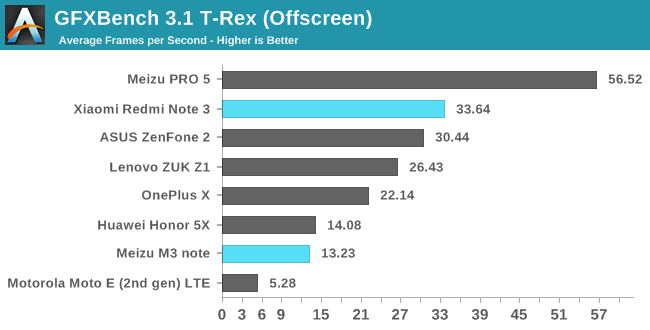
Starting with the older OpenGL ES 2.0-based T-Rex game simulation, the Redmi Note 3 separates itself from its peers, easily outperforming the M3 note by a factor of 2.5. Unlike with general system performance, the Redmi Note 3 cannot get close to the same level of performance as higher-priced flagships; the Meizu PRO 5’s Mali-T760MP8 GPU is 68% faster in this test.
The M3 note performs about the same as the Honor 5X and its Adreno 405 GPU. It will be interesting to see if this holds in our other tests. Other than the Moto E, all of the phones in the charts above have 1080p displays, so there’s no real difference between onscreen and offscreen results. The Moto E’s onscreen performance is actually the same as the M3 note’s, albeit at a lower resolution.
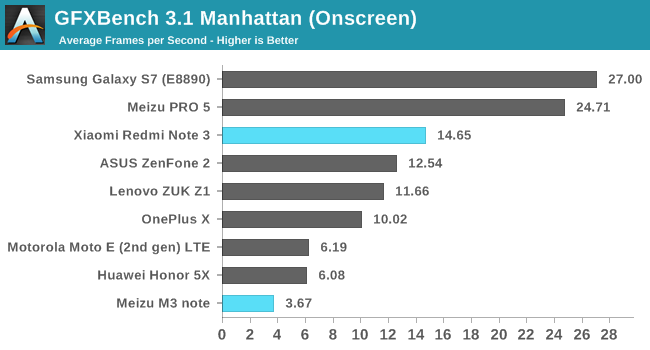
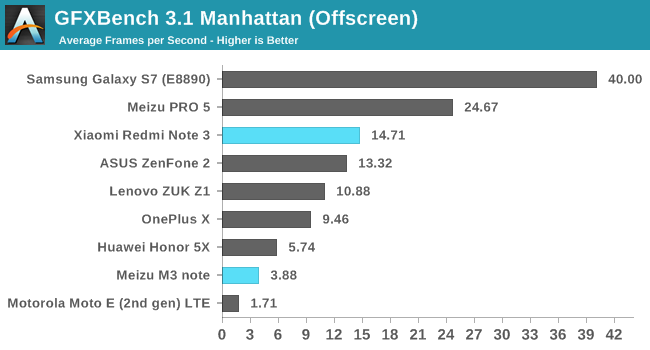

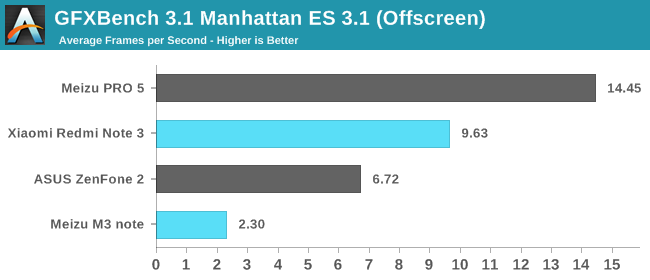
Because only two other phones in this roundup could run the GFXBench Manhattan ES 3.1 test—a point showing that both the M3 note and Redmi Note 3 are ahead of the curve when it comes to graphics API support—we’re also including the results from GFXBench Manhattan, which uses an OpenGL ES 3.0 game engine that stresses lighting and pixel effects.
In Manhattan 3.0, the Redmi Note 3 once again outperforms the non-flagship phones, managing to just stay ahead of the ASUS ZenFone 2. The M3 note falls behind the Honor 5X with a more pixel-heavy workload. It’s even slower than the Moto E’s Adreno 306 GPU when running onscreen. The T860 GPU with only two cores seems insufficient when paired with the M3 note’s 1080p display.
The Redmi Note 3 extends its lead over the ZenFone 2 when running the newer OpenGL ES 3.1 version of Manhattan, while the M3 note continues to struggle.
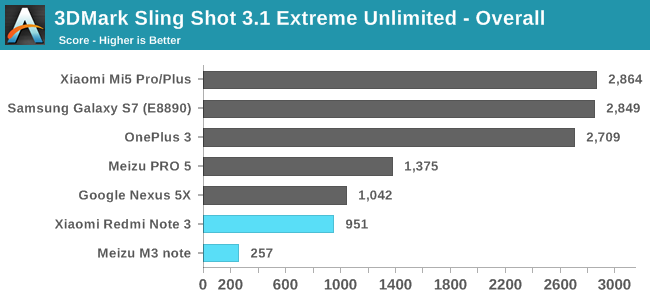
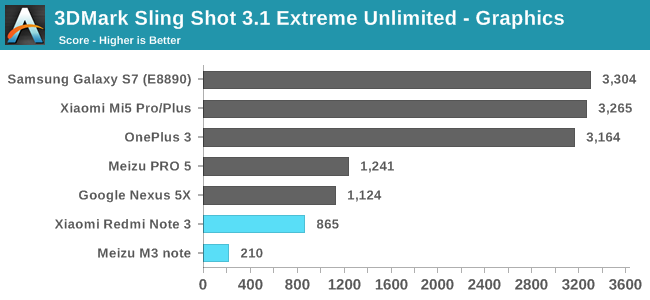
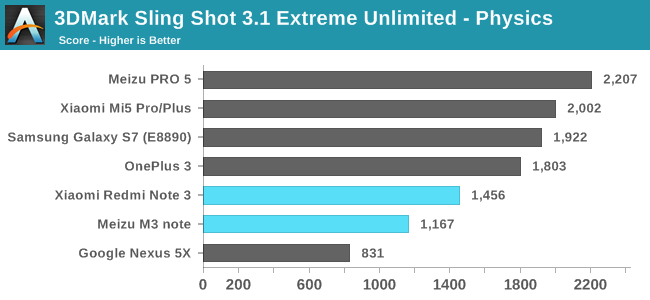
3DMark Sling Shot Extreme is another OpenGL ES 3.1 game simulation test that stresses the GPU and memory subsystems by rendering offscreen at 1440p (instead of 1080p like our other tests). This test best highlights the disparity in peak graphics performance between flagship phones and less-expensive models. The Adreno 530 GPU in the OnePlus 3 and Xiaomi Mi5, along with the Mali-T880MP12 in the Galaxy S7, delivers more than 3x the peak performance than the Redmi Note 3. The M3 note, meanwhile, really struggles at such a high resolution, falling even further behind the Redmi Note 3.
The M3 note consistently crashes when running Basemark ES 3.1, even though this OpenGL ES 3.1 test does not use tessellation. The Redmi Note 3 runs the test fine and scores the same as the Nexus 5X.
After seeing how these two phones performed during formal testing, I downloaded a few games from Google Play to see how they handled some real game code. The Redmi Note 3 loaded games more quickly than the M3 note and maintained playable frame rates in “Brothers in Arms 3,” a third-person shooter released at the end of 2014, and “CSR Racing 2,” a popular game based on OpenGL ES 3.0. There were some occasional stutters, but overall the games were playable. The chassis did get warm but not uncomfortably so.
The M3 note had no trouble keeping the frame rate above 45fps in “Angry Birds Star Wars II,” but the other two games I tried were not playable. Even at the lowest quality setting, “Brothers in Arms 3” chugged along at 8-12fps, and “CSR Racing 2” was not any better, averaging around 15fps.
Based on our testing and first-hand experience, the Redmi Note 3 should handle most games currently available. It supports the latest graphics APIs, including support for tessellation, and is powerful enough to provide an adequate gaming experience, although gameplay will not always be perfectly smooth. The M3 note, like most phones in this price range, struggles when playing more demanding games. It’s certainly fine for playing casual games, such as side scrollers and puzzles, but its two-core GPU is undersized for playing 3D content at 1080p.










79 Comments
View All Comments
A5 - Tuesday, July 12, 2016 - link
Review should maybe note that this a review of the Redmi Note 3 PRO, not the non-PRO version that has the Helio X10 in it.R0H1T - Tuesday, July 12, 2016 - link
@A5 except the RN3 is what it's called in the rest of the world, RN3 Pro only exists in China & AFAIK other regions have only gotten the SD650 variants of the RN3, that don't end with Pro.Death666Angel - Tuesday, July 12, 2016 - link
Nope. RN3Pro is the SD650 one, RN3 is the Helio X10 one and I can buy both in Germany and I guess the rest of Europe or at least the EU through importers.Alexey291 - Tuesday, July 12, 2016 - link
I was about to write that these guys are so 'busy' these days that they can't even get the camera name right...Alexey291 - Tuesday, July 12, 2016 - link
Phone not camera dammitzeeBomb - Tuesday, July 12, 2016 - link
Which one you can actually use US/CAN radios and is more readily available internationallyv than China?BMNify - Tuesday, July 12, 2016 - link
Both the Meizu M3 note and the Xiaomi Redmi note 3 are available in India. The Xiaomi model is available in all the countries where Xiaomi sells officially.fanofanand - Tuesday, July 12, 2016 - link
Excellent review. They need to get LTE on that Redmi Note 3, that is precisely the type of phone I want. I don't have the vision to tell when a screen isn't ideal, I very rarely listen to audio over the speaker, but I want strong performance and long battery life. At least the Chinese companies are listening!adityarjun - Tuesday, July 12, 2016 - link
I have a question for the techies here. I posted in reddit but got no response. What part of a mobile is responsible for implementing the bands? For example, both OnePlus 3 and Samsung S7 have SD820 with X12 modem but both support a different set of bands. So, what gives?Matt Humrick - Tuesday, July 12, 2016 - link
The modem or baseband processor is only one component in the cellular hardware chain. Here's an article that explains the roles for each component: http://www.anandtech.com/show/6541/the-state-of-qu...